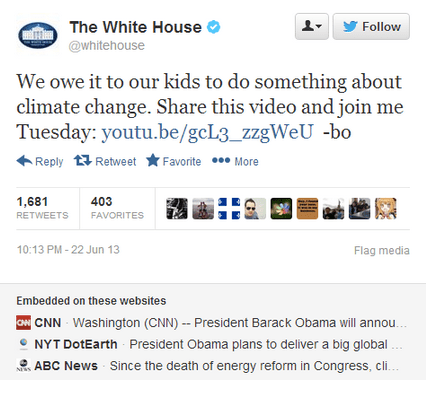Twitter has started to test a new feature related to its embedded tweet service: a list of links, below the tweet, where a tweet has been referenced. It’s the latest move in Twitter’s longer-term strategy to make the platform more interactive, which started a little over a year ago and has brought us Twitter cards with previews, as well as the shortcodes for users to create pictures of the tweets — aka embedded tweets — elsewhere.
For now, this looks like only a limited test. Mikko Hypponen, the outspoken chief research officer at F-Secure who first brought this to our attention, has also noted that the feature has come and gone, and returned during the day.
I haven’t been able to see the links myself, but you can in a screenshot (shown here in a Twitter embedded tweet link:)
Has Twitter always shown where particular tweets are embedded on? pic.twitter.com/Th5y94omPZ
— Mikko Hypponen ✘ (@mikko) July 1, 2013
The links in turn go directly to the pages on the sites, not to tweets, Hypponen told me.
I asked Twitter about what is going on, and a spokesperson pointed me in the direction of this blog post noting tests of “hundreds of variations of new features and designs.”
Regardless of whether or not this feature eventually rolls out to a wider public, listing where a tweet has been used is another sign of how Twitter hopes to continue to make its platform more interactive and less lean-back.
Getting the balance to tip further in the direction of engaged users will mean that Twitter can sell itself better as a broadcasting platform to advertisers hungry to go not just where registered users are congregating, but specifically to where users are logging on, paying attention, and clicking. Conversely, giving users a list of links showing where else a tweet has “travelled” outside of Twitter is a good way of driving more usage of the embedded link feature, and getting more people to effectively become marketers of Twitter itself.
There is also a practical need for something like this to help “close the loop,” as online marketers like to say, between presenting information and actually acting on it. Anecdotally, I’ve noticed that dozens of retweets (much less favorites) of a link do not necessarily translate to traffic to a particular page. It seems that many Twitter users, lured in by the fast pace of Twitter, are happy to use it as its chief source of information as well. Offering one more bit of context — in the form of the history of the embed — could be one way for Twitter and would be users of the embed service to drive more actions from that tweet.
You can also see how a list of links may potentially also come to include a sponsor in the mix, taking advantage of the Google-Adwords-style keyword targeting advertising that Twitter has been rolling out.
